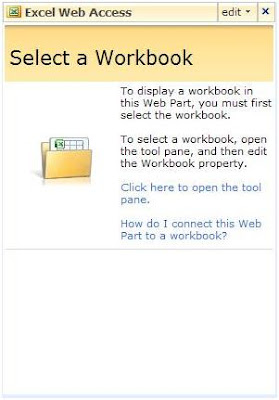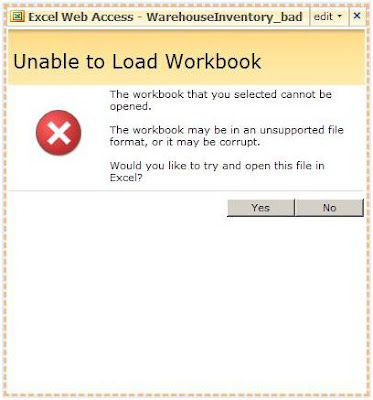Thursday, September 6, 2007
Silverlight 1.0 Released
Silverlight essentially creates JavaScript that is stored on the server but executed entirely on the client. To help expedite this process, Microsoft Expressions can be used to create the graphics and animation. Although SilverLight version 1.0 does not include .Net APIs, version 1.1 is expected to have it.
To learn more about Silverlight, check out the following links:
Download: http://www.microsoft.com/silverlight/default_ns.aspx.
News: http://www.microsoft.com/silverlight/news-pr.aspx
Community: http://www.microsoft.com/silverlight/community.aspx
Resources: http://www.microsoft.com/silverlight/downloads.aspx
Friday, August 31, 2007
XML Schema Designer
To download v1(beta) of this new tool, go to http://www.microsoft.com/downloads/details.aspx?FamilyID=4DE12C98-1221-4A0E-B5AA-BFC7DAF02550&displaylang=en
Wednesday, August 29, 2007
SharePoint Server 2007 SDK Released
Thursday, August 23, 2007
Description of the "Lorem ipsum dolor sit amet"
Although the phrase is nonsense, it does have a long history. The phrase has been used for several centuries by typographers to show the most distinctive features of their fonts. It is used because the letters involved and the letter spacing in those combinations reveal, at their best, the weight, design, and other important features of the typeface. A 1994 issue of "Before & After" magazine traces "Lorem ipsum ..." to a jumbled Latin version of a passage from de Finibus Bonorum et Malorum, a treatise on the theory of ethics written by Cicero in 45 B.C. The passage "Lorem ipsum ..." is taken from text that reads, "Neque porro quisquam est qui dolorem ipsum quia dolor sit amet, consectetur, adipisci velit ...," which translates as, "There is no one who loves pain itself, who seeks after it and wants to have it, simply because it is pain..."
To read more about this, go to http://support.microsoft.com/kb/114222
Wednesday, August 22, 2007
Using Word 2007 Templates
A: Using Templates in Office 2007 is one of the easiest tasks you will ever use. Basically a template document contains all the specifications for font, color, and the overall appearance of the document. To create and use a template, simply follow the procedure below.
Creating a Word Template
1. Open Microsoft Word 2007. By default, Word will open a blank document (.docx).
2. Modify the document so it contains all the cosmetic elements you want to appear in all future documents that will use this template.
3. Click the Office button (located in the upper left corner of the Window) and select “Save As”. After specifying the “File name”, change the “Save as type” to “Word Template (*.dotx)”.
and select “Save As”. After specifying the “File name”, change the “Save as type” to “Word Template (*.dotx)”.
Using a Word Template
1. When you need to create a document that reflects all the elements created in the template, simply open the template.
2. The next time you click “Save”, Word 2007 will automatically save the changes to a new document (.docx), leaving the template in place as-is.
Templates work the same way for all applications in the Office 2007 suite. Microsoft has hundreds of Office 2007 templates available for download, free of charge. To view these templates by category, go to http://office.microsoft.com/en-us/templates/CT101485751033.aspx
Tuesday, July 31, 2007
Setting Trusted Locations in MOSS 2007
Create Document Library (with Excel as the default type)
1. Open the Home page to your site collection (i.e. http://moss101/Pages/Default.aspx)
2. Click “View All Site Content”
3. Click "Create"
4. Click "Document Library"
5. Specify all the settings for the library, using Excel 2003 as the default type. For the sake of this example, the document library will be called “Warehouse Documents”.
6. A document library called "Warehouse Documents" is now created, accessible at http://moss101/Warehouse%20Documents/Forms/AllItems.aspx
Make it a trusted location
1. Click "Central Administration"
2. Click "Shared Services Administration"
3. Click the Shared Service (i.e. "SharedServices1(Default)" )
4. Click "open Shared Service Administration"
5. Click "Trusted File Locations", located under "Excel Services Settings"
6. Click "Add Trusted File Location"
7. Paste URL of document library (http://moss101/Warehouse%20Documents/Forms/AllItems.aspx)
Upload sample spreadsheet
1. Maneuver to the Document Library (http://moss101/Warehouse%20Documents/Forms/AllItems.aspx) and click upload
2. Upload an Excel document in .XLSX format. Note: Document must be in Excel 2007 format (.XSLX) to work with the EWS web parts. Otherwise the web part will produce an error message similar to the one below:
The workbook that you selected cannot be opened.
The workbook may be in an unsupported file format, or it may be corrupt.
Add Excel Web part
1. Open the Home page to your site collection (i.e. http://moss101/Pages/Default.aspx) .
2. Click “Site Actions” in the upper right hand corner of the page
3. Click “Edit Page”.
4. Click “Add a Web Part” in the desired zone.
5. From the pop-up box, select “Excel Web Access” web part and click “Add”. The web part will then appear in the selected web part zone as seen below:

6. Within the web part, click the link “Click here to open the tool pane” to configure the web part.
7. In the settings pane, use the ellipsis button (button with 3 dots) to maneuver to the document library created previously.
8. From the document library, select a spreadsheet in Excel 2007 format. Selecting any other format will result in the following error message:

Monday, July 30, 2007
SQL Server 2000 End-of-Life Support
For those with projects utilizing SQL Server 2000, Microsoft issued End of Life dates for support.
- Mainstream Support End of Life - April 8, 2008
- Extended Support End of Life - April 9, 2013
End of "free" support
Hot fixes (non-security related) will require an extended hot fix support agreement to be purchased
Microsoft will not support warranty support, new features, or design changes
Security updates will continue to be provided
Microsoft Support Lifecycle: http://support.microsoft.com/lifecycle/
MS SQL 2000 Lifecycle: http://support.microsoft.com/lifecycle/?LN=en-us&p1=2852&x=9&y=11
With the retirement of SQL Server 2000 around the corner, this brings up an interesting question for MCAD/MCSD candidates: Will this impact certification Exam 70–229: Designing and Implementing Databases with Microsoft SQL Server 2000 Enterprise Edition? When will the exam be retired?
Given Microsoft is still promoting the MCDBA certification on their site, I'm guessing 70-229 is safe for the moment. The exam is not currently scheduled for retirement at this point (http://www.microsoft.com/learning/mcpexams/status/examstoretire.mspx) nor is it on the "Discontinued Microsoft Certification exams" list (http://www.microsoft.com/learning/mcpexams/status/examsretired.mspx).
For more info, visit the following links:
http://www.microsoft.com/learning/mcpexams/status/retired.mspx
http://blogs.msdn.com/trika/archive/2007/07/03/lifecycle-of-new-generation-certifications.aspx
http://blogs.msdn.com/trika/archive/2007/06/14/windows-server-2008-certification-paths.aspx
http://www.microsoft.com/learning/mcp/mcdba/upgrade/default.mspx
For specific questions, e-mail them to mcphelp@microsoft.com
Tuesday, July 17, 2007
Classic UI Tabs for Office 2007
Friday, July 6, 2007
Debugging Stored Procedure in Visual Studio 2005
http://clevelanddotnet.blogspot.com/2007/05/follow-up-questions.html.
Tuesday, June 12, 2007
Working with double quotes (") in VB.Net
Ironically enough, in VB the double quote can also be used as an escape character when searching for it in a string. For example:
Dim strTest As String
strTest = """123""" 'Displays "123" (double quotes appear in the final result)
strTest = """""123""" 'Displays ""123" (double quotes appear in the final result)
strTest = "test\""test" 'Displays test\"test
strTest = "test""test" 'Displays test"test
In cases where you want to insert a double quote character, simply reference it unicode character designation, chr(34). For example:
strTest = Chr(34) 'Displays "
Switching gears for a moment, ever wonder what would the result be if used nested string functions. Consider the following example:
strTest = strTest.Replace("""", "").Replace("""", "X") 'Displays testtest; executes functions from left to right
Thursday, May 24, 2007
Follow-up questions
Q: I have alot of VBA experience and would like to learn VB.Net. What resources are available that can help with this?
A: There are several sites available online to assist with this. For starters, check out the following links:
http://msdn.microsoft.com/vstudio/express
http://msdn.microsoft.com/vstudio/express/beginner
http://safari.oreilly.com
http://www.bookpool.com
http://www.nerdbooks.com
Q: I created an application as a web site. Is there difference in deploying it between a web site application and a web
project application? Is there any way to deploy it as a web site application?
A: ASP.Net 2.0 "web sites" are different from the "web projects" you worked with in VS2003. Deploying a web site in VS2005
requires a different procedure (see http://www.odetocode.com/Articles/417.aspx for more information). If you want to build
and deploy web applications in VS2005 the same way you did in VS2003, you will need to download VS2005 SP1
(http://www.microsoft.com/downloads/thankyou.aspx?familyId=bb4a75ab-e2d4-4c96-b39d-37baf6b5b1dc&displayLang=en ). This will
allow you to create a "web project" in VS2005 and deploythe same way you did in VS2003, as opposed to the existing web site.
After you install SP1, you will be able to see the web project template in VS2005. Until then, you can only create a web
site
Q: How can I step through a stored procedure while debugging code?
A: Check out "Debugging SQL Server 2005 Stored Procedures in Visual Studio"
(http://aspnet.4guysfromrolla.com/articles/051607-1.aspx)
Q: How long will VB6 be supported?
A: Visual Basic 6.0 runtime will be supported for the full lifetime of Windows Vista, which is five years of mainstream support followed by five years of extended support”, which means it is supported until at least 2017. For more info, please visit http://msdn2.microsoft.com/en-us/vbrun/ms788708.aspx
Thanks to all who contributed to the meeting and the discussion. For more information on upcoming meetings, please visit www.clevelanddotnet.info. All meetings are free an open to all developers.
Thursday, May 3, 2007
DotNetNuke Follow-up Questions
Q: What are the System Requirements for DNN?
A: Win2003 server, IIS, ASP.Net 2.0
Q: Does DNN install as a "web-site" or does it take over IIS?
A: DNN installs as a simple web site application. Installation in simple, and by Default it installs with SQL Server Express.
Q: Can DNN sites be crawled by internet search engines?
A: DNN sites can be crawled. The menu actually checks the HTTP user agent string to see if a spider is hitting the site and presents an alternative menu to make it easier for the spider to crawl the site.
Q: Is everything stored in the DB, much like SharePoint?
A: Most items are in the DB, much like SharePoint. Some organizations do DB migrations to move all content. There are some .JPG files or other resource files that are not stored in the DB directly. For the most part, everything is stored in the DB.
Q: Can SharePoint or ASP.Net 2.0 web parts be incorporated into DNN without customization? A: Web parts will not work without modification.
Q: What DBs does DNN support out of the box?
A: The databases supported are SQL Express, and SQL Standard to Enterprise. There are also third party data providers available for Oracle and MySQL.
